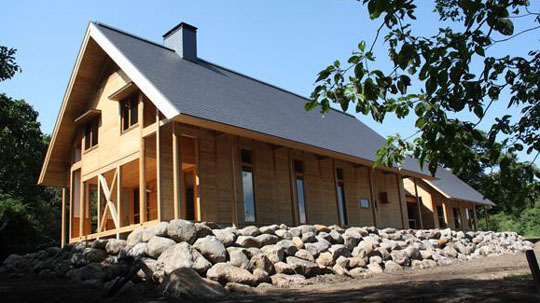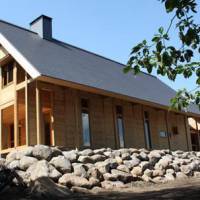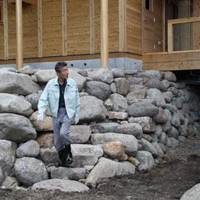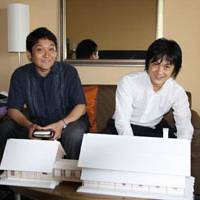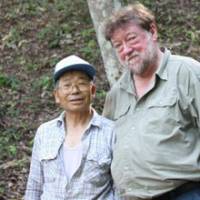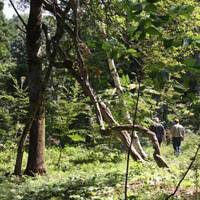Construction of the Afan Nature Centre here in our woods outside Kurohime in the Nagano Prefecture hills is complete and the keys have been handed over to us. The beautiful building is the result of a decade of wishing, three years of planning, and a year of onsite building.
For the 26 years since I started to buy neglected or abused woodland here, mixed with abandoned farmland that had reverted to scrubby brush, my avowed purpose has been to bring back a healthy biodiversity, to record the process, to teach — and to contribute in some small way to the restoration of nature and wildlife.
None of this could have been done without the local expertise of our forester, the doughty Mr. Nobuyoshi Matsuki.
I met Mr. Matsuki when I first came to live here in Kurohime in 1980. I got a gun licence, which wasn't easy as a foreigner, and joined the local Hunters' Association. This was not just to enable me to go out and bag a hare, duck or pheasant for the pot; I needed to make friends with local hunters, to learn from people who really knew the mountains. Mr. Matsuki was one of them.
Mr. Matsuki left school at the age of 15 to go into the hills and learn the trade of charcoal-burning; work that demands a great deal of woodcraft and a lot of time spent selecting and trimming out suitable logs and tending the kilns. You cannot leave a kiln full of wood to just burn; the steam and smoke must be watched and the inflow of air to the fire regulated for 24 hours a day. One mistake could have the whole lot turn to ash instead of charcoal.
As a general rule, coppiced hardwoods are used for charcoal, which results in a 30-year cut-and-regrow cycle. This usually implies a remote location somewhere in the mountains, so that while the charcoal is being made the workers had to build a self-sufficient hut using materials to hand.
Our own woodland now has convenient logging and hiking trails we have built ourselves so we can bring the logs to the kiln. This was not so when Mr. Matsuki was a young man. He used to spend weeks away from the village, living in and off the forest.
Then, in the heyday of Japanese logging either side of the 1964 Tokyo Olympics, Mr. Matsuki became a logger and a lumberjack. However, by the time I met him in the early 1980s, the government was steadfastly protecting the status and expenses of its rather rich and bloated Forestry Agency while cutting back on the wages and costs of the locally hired men who actually toiled in the woods.
By the time I began persuading Mr. Matsuki to help me restore woodland, he was mostly earning his living through construction work and mail delivery. All over Japan at that time, actual forestry skills were beginning to fall into a decline, with fewer and fewer younger men receiving essential training in the field.
The earliest photographs I have of Mr. Matsuki clearing brush on the first patch of land that I bought — which eventually became included into today's 30-hectare C.W. Nicol Afan Woodland Trust (which we hope to extend to 50 hectares) — are dated in 1986. It took a lot of persuasion to get him to come and work for me, and I can still understand his questioning at that time — along the lines of, "Why would a foreigner like you want to raise woodlands in Japan? What do you get out of it? It takes 20, 30 years to raise woods — are you going to be around for that time?"
I understood, but I can be very persistent. Finally convinced, he began officially working full-time in the woods with me about 20 years ago at the ripe young age of 55. When the trust was established in 2002, Mr. Matsuki became our Senior Forester.
A forester needs a hut, a place to store his tools and to rest and get out of the weather. For Mr. Matsuki, the hut became essential when tending the three- to four-day burning of the traditional (rebuilt on site) stone charcoal kiln, which converts trimmed-out wood to valuable charcoal and natural creosote distillate.
Mr. Matsuki's hut also became a gathering place for me, our other staff, guests and local visitors to sit around the wood stove for tea, rice crackers, chocolates, roast yams and corn, stew — and stories.
On its low benches, however, the hut can only hold six people at a time, so I longed for a place where we could entertain larger groups. I wanted a place where 30 people could sit down to dinner — or where as many as 40 or 50 could gather for a seminar.
Right from the start, though, I vowed that I would not allow trees to be felled to make space to build a center. As it happened, I had bought a parcel of land adjoining the woods upon which a dilapidated old cottage and an abandoned garden and vegetable patch stood, along with a magnificent chestnut tree. It was not woodland, but on clear days it offered a fine view of the distant Shiga range with Mount Reisenji in the background. That is where we have built the center.
I was very demanding about the budget and the design and I'm glad I stuck to my guns. The center is built entirely of Japanese timber, even though foreign timber was supposed to be cheaper and easier to obtain. The seemingly rough but artfully laid masonry utilizes stones and boulders that were washed down the Torii River running past my home in a major flood some years back.
The design is a blend of Celtic Wales with Japanese Snow Country and temple architecture, with a large hall that features a big river-stone hearth that is the very heart of the building. Ensuring a supply of firewood will take a lot of work, but it will be good exercise and no problem for us.
The kitchen is modern, with a gas stove and range, adequate refrigeration and a charcoal grill. The furniture is made by Japanese craftsmen from lumber trimmed out from our woods (leaving other trees to grow with more light and vigor). The tables and chairs in the main hall are of classic English design, made of harvested broadleaved hardwoods — oaks, walnut, mountain cherry, Japanese mountain dogwood and so on. The more modern furniture in the front office is made from larches cut from a stand of trees that badly needed trimming and as a result have very closely spaced annual rings due to them having grown only a little every year — which makes for dense, high-quality wood.
Meanwhile, all windows are double-glazed, and the building's insulation is made of specially imported Australian wool, a superb natural insulating material. No glass fiber or asbestos!
Perhaps oddly, though, some may think, the main hall will have no permanent hanging pictures nor static exhibits, except on special occasions. After all, the center is attached to living woodland so there is enough to see and hear there! To that end we are installing a high-definition camera, set on a four-meter-high stand that's sited 120 meters into the actual woods, overlooking ponds and trees and a distant peak. Live pictures will be cabled to a big plasma screen in the hall on which we can also show DVDs, documentaries and lecture material. As well, we are negotiating to set up live tele-links with the Afan Argoed Forest Park in South Wales, which is in the next-door valley to the town of Neath where I was born.
Our dream is to "show and tell," in real time, everything we can about woods, wildlife and forest cultures to school children, students, forest workers, researchers and all kinds of nice people. Who knows what we will be asked — Do you guys have violets? What about orchids? Any bears, deer, or wild boar? How do you go about cooking a traditional roast haunch of venison? How do you prepare wild mountain vegetables or mushrooms? All that, and I'm sure many of you can imagine a score of other themes.
My dream is that we start our overseas links with Wales and then try to expand our reach and set up a kind of global, friendly network of "united forests."
However, we have lots of work to do at home as well. There's all that firewood to cut, haul, split and stack. We have to move in and settle down, as well as get ready for a series of opening parties. Then there's all that new technology to wrestle with and the grounds immediately around the center to be landscaped with native trees and plants — and native wild strawberries, violets and kitchen herbs to be planted in the interstices between the boulders of the outer ramparts.
In addition, we have to inform our members and supporters of our new location and address, since this new Afan Nature Centre is not intended to be a place for casual visitors to walk in and gawk around — and there's no coffee shop nor store to sell trinkets. The center is intended to be for trust members, friends, and special guests. My dream is that it will become a new nexus for sharing problems and practices, and for exchanging worldwide ideas and hopes for renewing forests, woodlands and wildlife — and all the wonderful things that go along with them. How about joining us?
For more information about The Afan Woodland Trust, including how to become a member, visit [email protected].



